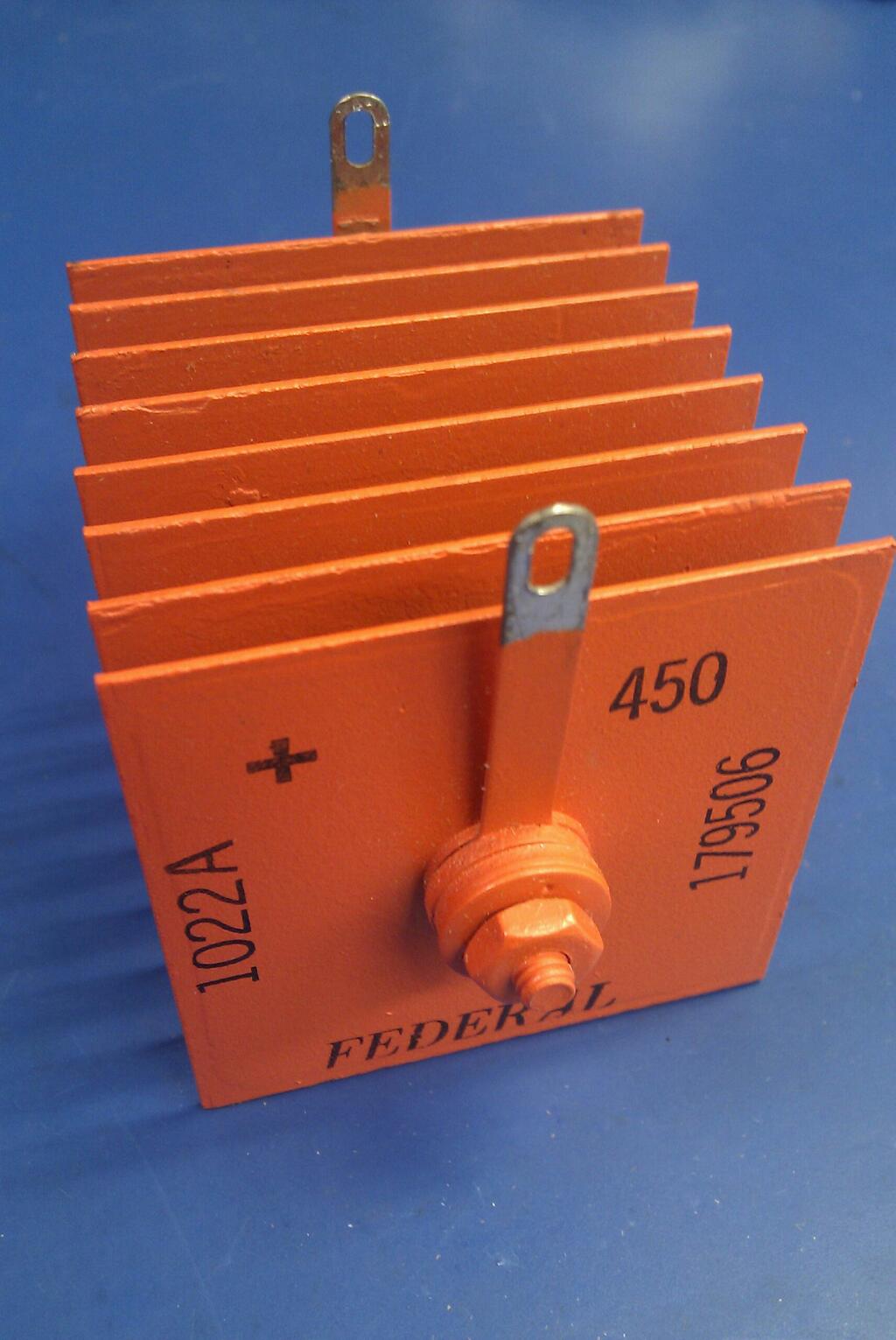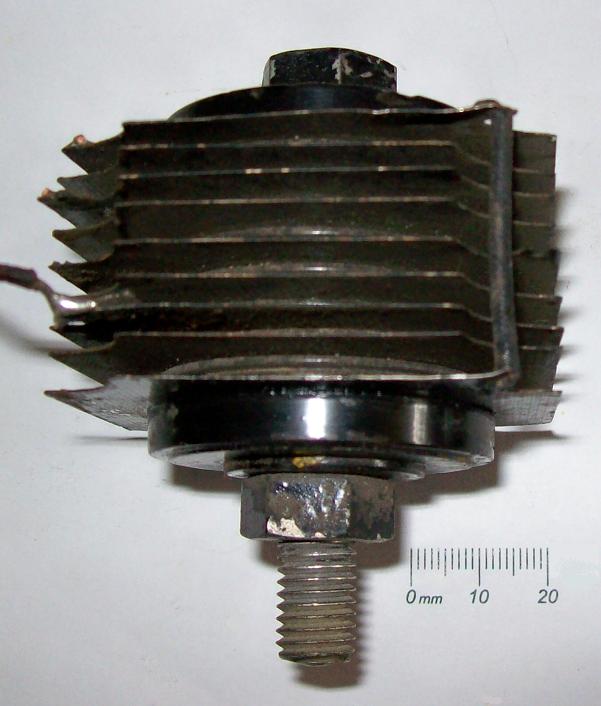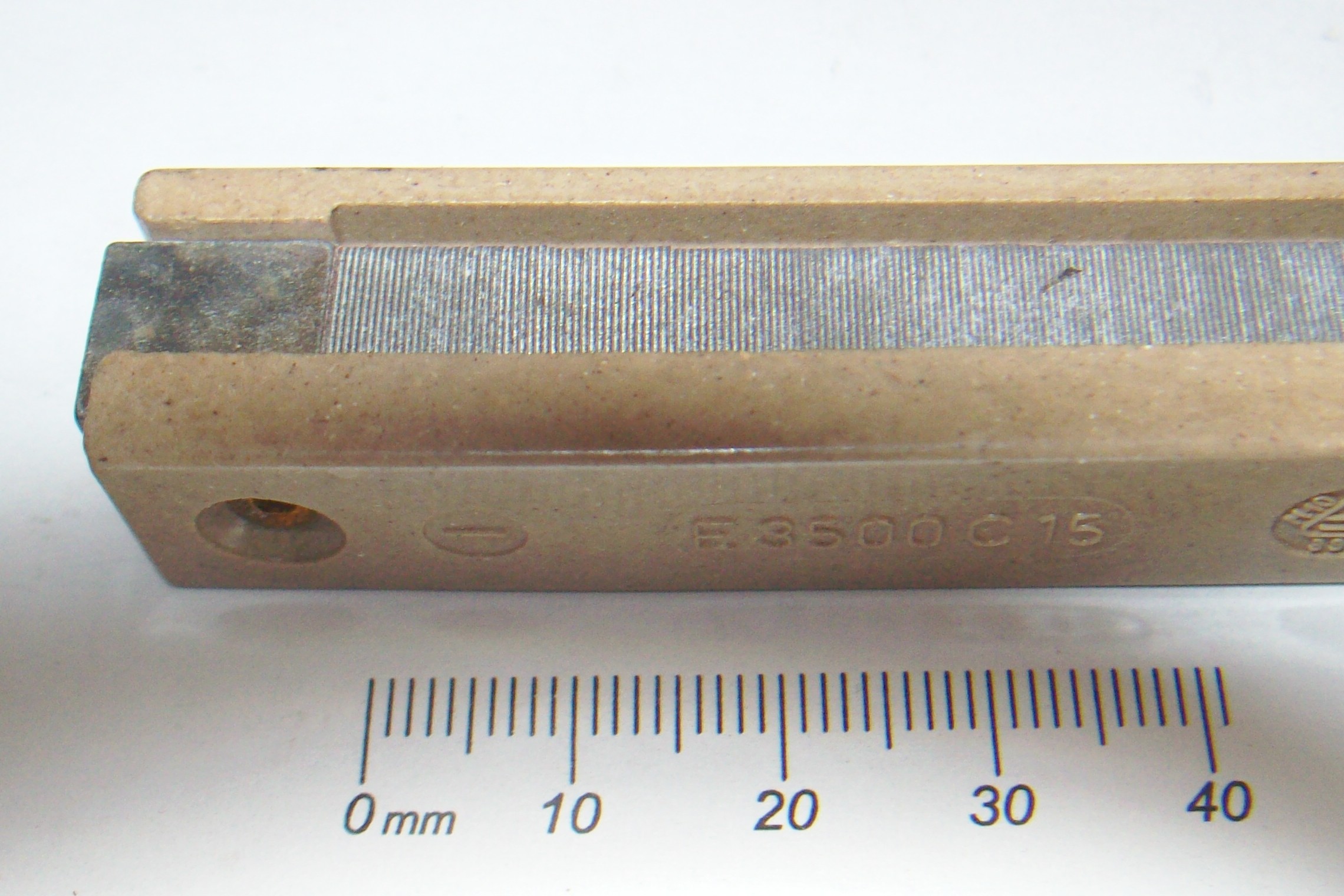metal rectifier on:
[Wikipedia]
[Google]
[Amazon]
 A metal rectifier is an early type of
A metal rectifier is an early type of
 Metal rectifiers consist of washer-like discs of different metals, either
Metal rectifiers consist of washer-like discs of different metals, either
 Specially designed selenium rectifiers were once widely used as EHT rectifiers in television sets and photocopiers. A layer of selenium was applied to a sheet of soft iron foil, and thousands of tiny discs (typically 2mm diameter) were punched out of this and assembled as "stacks" inside ceramic tubes. Rectifiers capable of supplying tens of thousands of volts could be made this way. Their internal resistance was extremely high, but most EHT applications only required a few hundred microamps at most, so this was not normally an issue. With the development of inexpensive high voltage silicon rectifiers, this technology has fallen into disuse.
Specially designed selenium rectifiers were once widely used as EHT rectifiers in television sets and photocopiers. A layer of selenium was applied to a sheet of soft iron foil, and thousands of tiny discs (typically 2mm diameter) were punched out of this and assembled as "stacks" inside ceramic tubes. Rectifiers capable of supplying tens of thousands of volts could be made this way. Their internal resistance was extremely high, but most EHT applications only required a few hundred microamps at most, so this was not normally an issue. With the development of inexpensive high voltage silicon rectifiers, this technology has fallen into disuse.
Rectifier used as an AM-demodulator
Cougar Electronics - example of "legacy" selenium rectifier manufacturer
The Copper Oxide Rectifier
This document discusses the history of the copper oxide rectifier, and, in particular, the use of Chilean copper in its manufacture; the thallium catastrophe that befell the manufacture of selenium rectifiers is also discussed. Semiconductor devices Rectifiers
 A metal rectifier is an early type of
A metal rectifier is an early type of semiconductor
A semiconductor is a material with electrical conductivity between that of a conductor and an insulator. Its conductivity can be modified by adding impurities (" doping") to its crystal structure. When two regions with different doping level ...
rectifier
A rectifier is an electrical device that converts alternating current (AC), which periodically reverses direction, to direct current (DC), which flows in only one direction.
The process is known as ''rectification'', since it "straightens" t ...
in which the semiconductor is copper oxide, germanium
Germanium is a chemical element; it has Symbol (chemistry), symbol Ge and atomic number 32. It is lustrous, hard-brittle, grayish-white and similar in appearance to silicon. It is a metalloid or a nonmetal in the carbon group that is chemically ...
or selenium
Selenium is a chemical element; it has symbol (chemistry), symbol Se and atomic number 34. It has various physical appearances, including a brick-red powder, a vitreous black solid, and a grey metallic-looking form. It seldom occurs in this elem ...
. They were used in power applications to convert alternating current
Alternating current (AC) is an electric current that periodically reverses direction and changes its magnitude continuously with time, in contrast to direct current (DC), which flows only in one direction. Alternating current is the form in w ...
to direct current
Direct current (DC) is one-directional electric current, flow of electric charge. An electrochemical cell is a prime example of DC power. Direct current may flow through a conductor (material), conductor such as a wire, but can also flow throug ...
in devices such as radios and battery charger
A battery charger, recharger, or simply charger, is a device that stores energy in an electric battery by running current through it. The charging protocol—how much voltage and current, for how long and what to do when charging is complete� ...
s. Westinghouse Electric
The Westinghouse Electric Corporation was an American manufacturing company founded in 1886 by George Westinghouse and headquartered in Pittsburgh, Pennsylvania. It was originally named "Westinghouse Electric & Manufacturing Company" and was ...
was a major manufacturer of these rectifiers since the late 1920s, under the trade name Westector (now used as a trade name for an overcurrent trip device by Westinghouse Nuclear).
In some countries the term "metal rectifier" is applied to all such devices; in others the term "metal rectifier" normally refers to copper-oxide types, and " selenium rectifier" to selenium-iron types.
Description
 Metal rectifiers consist of washer-like discs of different metals, either
Metal rectifiers consist of washer-like discs of different metals, either copper
Copper is a chemical element; it has symbol Cu (from Latin ) and atomic number 29. It is a soft, malleable, and ductile metal with very high thermal and electrical conductivity. A freshly exposed surface of pure copper has a pinkish-orang ...
(with an oxide
An oxide () is a chemical compound containing at least one oxygen atom and one other element in its chemical formula. "Oxide" itself is the dianion (anion bearing a net charge of −2) of oxygen, an O2− ion with oxygen in the oxidation st ...
layer to provide the rectification) or steel
Steel is an alloy of iron and carbon that demonstrates improved mechanical properties compared to the pure form of iron. Due to steel's high Young's modulus, elastic modulus, Yield (engineering), yield strength, Fracture, fracture strength a ...
or aluminium
Aluminium (or aluminum in North American English) is a chemical element; it has chemical symbol, symbol Al and atomic number 13. It has a density lower than that of other common metals, about one-third that of steel. Aluminium has ...
, plated
Plating is a finishing process in which a metal is deposited on a surface. Plating has been done for hundreds of years; it is also critical for modern technology. Plating is used to decorate objects, for corrosion inhibition, to improve solderab ...
with selenium
Selenium is a chemical element; it has symbol (chemistry), symbol Se and atomic number 34. It has various physical appearances, including a brick-red powder, a vitreous black solid, and a grey metallic-looking form. It seldom occurs in this elem ...
. The discs are often separated by spacer sleeves to provide cooling.
Mode of operation
The principle of operation of a metal rectifier is related to modern semiconductor rectifiers (Schottky diode
The Schottky diode (named after the German physicist Walter H. Schottky), also known as Schottky barrier diode or hot-carrier diode, is a semiconductor diode formed by the junction of a semiconductor with a metal. It has a low forward voltag ...
s and p–n diodes), but somewhat more complex. Both selenium and copper oxide are semiconductors, in practice doped by impurities during manufacture. When they are deposited on metals, it would be expected that the result is a simple metal–semiconductor junction and that the rectification would be a result of a Schottky barrier
A Schottky barrier, named after Walter H. Schottky, is a potential energy barrier for electrons formed at a metal–semiconductor junction. Schottky barriers have rectifier, rectifying characteristics, suitable for use as a diode. One of the p ...
.
However, this is not always the case: Siegfried Poganski discovered in the 1940s that the best selenium rectifiers were in fact semiconductor-semiconductor junctions between selenium and a thin cadmium selenide layer, generated out of the cadmium-tin metal coating during processing.
In any case the result is that there is a depletion region in the semiconductor, with a built-in electric field, and this provides the rectifying action.
Performance
Compared to later silicon or germanium devices, copper-oxide rectifiers tended to have poor efficiency, and the reverse voltage rating was rarely more than a few volts. A number of rectifier discs would need to be used in series to provide an adequate reverse breakdown voltage figure – a bridge rectifier for a 12V battery charger would often use 12 metal rectifiers. Selenium rectifiers were generally more efficient than metal-oxide types, and could handle higher voltages. However, considerably more skill was required for their construction.Applications
Radio receivers
Metal rectifiers were also used asenvelope detector
An envelope detector (sometimes called a peak detector) is an electronic circuit that takes a (relatively) high-frequency signal as input and outputs the '' envelope'' of the original signal.
Diode detector
A simple form of envelope detect ...
(AM demodulator) diode
A diode is a two-Terminal (electronics), terminal electronic component that conducts electric current primarily in One-way traffic, one direction (asymmetric electrical conductance, conductance). It has low (ideally zero) Electrical resistance ...
s in radio receivers. The WX6 Westector was a typical example. It was about the size and shape of an AAA battery
The AAA battery (or triple-A battery) is a standard size of dry cell battery. One or more AAA batteries are commonly used in low-drain portable electronic devices. A zinc–carbon battery in this size is designated by IEC as R03, by ANSI C ...
, with threaded posts at each end to which connections were made.
Selenium rectifiers were once widely used as high-voltage rectifiers in transformerless radio and TV sets, before cheaper silicon diodes became available. Although they were reasonably efficient in this application, (at least compared to vacuum-tube rectifiers), their internal resistance tended to increase as they aged. Apart from reducing the available high voltage
High voltage electricity refers to electrical potential large enough to cause injury or damage. In certain industries, ''high voltage'' refers to voltage above a certain threshold. Equipment and conductors that carry high voltage warrant sp ...
, this tends to make them run hotter, producing an unpleasant smell as the selenium starts to evaporate.
TV sets and photocopiers
 Specially designed selenium rectifiers were once widely used as EHT rectifiers in television sets and photocopiers. A layer of selenium was applied to a sheet of soft iron foil, and thousands of tiny discs (typically 2mm diameter) were punched out of this and assembled as "stacks" inside ceramic tubes. Rectifiers capable of supplying tens of thousands of volts could be made this way. Their internal resistance was extremely high, but most EHT applications only required a few hundred microamps at most, so this was not normally an issue. With the development of inexpensive high voltage silicon rectifiers, this technology has fallen into disuse.
Specially designed selenium rectifiers were once widely used as EHT rectifiers in television sets and photocopiers. A layer of selenium was applied to a sheet of soft iron foil, and thousands of tiny discs (typically 2mm diameter) were punched out of this and assembled as "stacks" inside ceramic tubes. Rectifiers capable of supplying tens of thousands of volts could be made this way. Their internal resistance was extremely high, but most EHT applications only required a few hundred microamps at most, so this was not normally an issue. With the development of inexpensive high voltage silicon rectifiers, this technology has fallen into disuse.
Electrolysis
Metal rectifiers have been replaced by silicon diodes in most devices, however there are certain applications where the replacement of metal rectifiers with silicon units has proven impractical. These are mostly inelectroplating
Electroplating, also known as electrochemical deposition or electrodeposition, is a process for producing a metal coating on a solid substrate through the redox, reduction of cations of that metal by means of a direct current, direct electric cur ...
, aluminium smelting
Aluminium smelting is the process of extracting aluminium from its oxide, alumina, generally by the Hall-Héroult process. Alumina is extracted from the ore bauxite by means of the Bayer process at an alumina refinery.
This is an electroly ...
and similar high-current low-voltage industrial applications, where the lower forward voltage drop
In electronics, voltage drop is the decrease of electric potential along the path of a current flowing in a circuit. Voltage drops in the internal resistance of the source, across conductors, across contacts, and across connectors are unde ...
of metal rectifiers is more important than their reverse breakdown voltage
The breakdown voltage of an insulator (electrical), insulator is the minimum voltage that causes a portion of an insulator to experience electrical breakdown and become electrically Conductor (material), conductive.
For diodes, the breakdown vo ...
.
References
External links
{{commons category multi, Copper-oxide rectifiers, Selenium rectifiersRectifier used as an AM-demodulator
Cougar Electronics - example of "legacy" selenium rectifier manufacturer
The Copper Oxide Rectifier
This document discusses the history of the copper oxide rectifier, and, in particular, the use of Chilean copper in its manufacture; the thallium catastrophe that befell the manufacture of selenium rectifiers is also discussed. Semiconductor devices Rectifiers